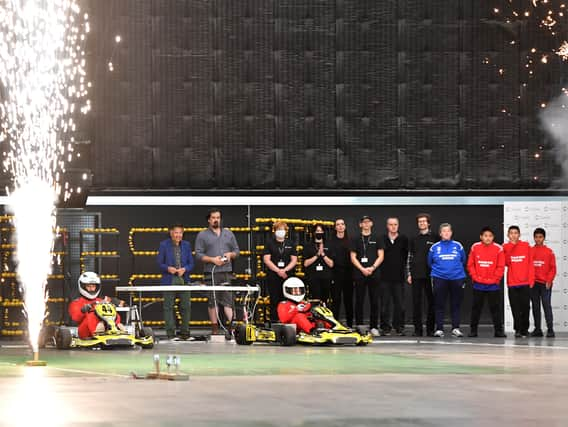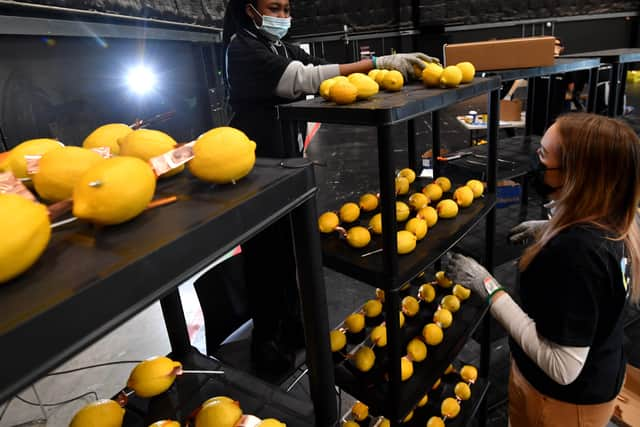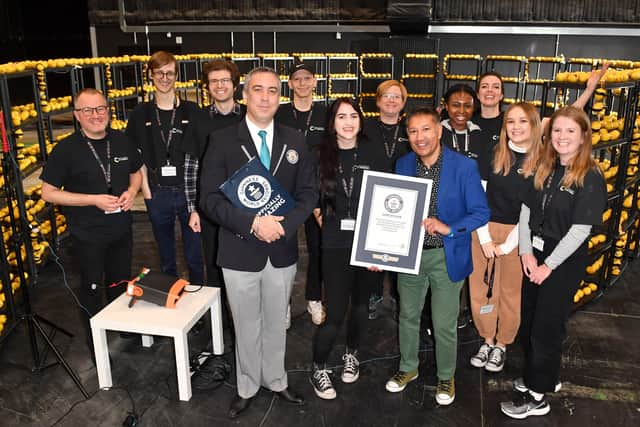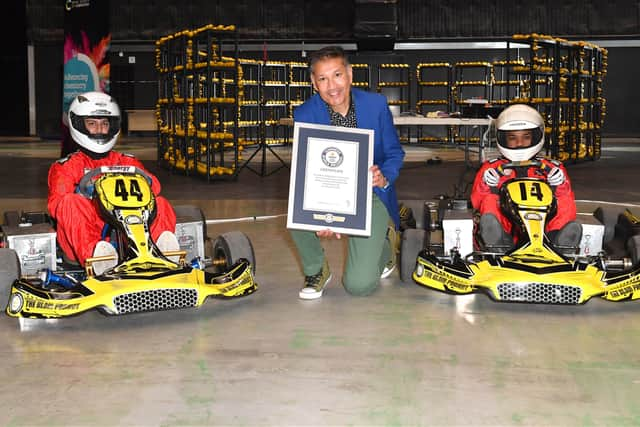The world’s largest fruit battery that can power a go-kart - using lemons


Science experts teamed up with a Manchester social enterprise to race into the Guinness Book of Records by creating the world’s largest fruit battery.
Boffins at the Royal Society of Chemistry (RSC) squeezed every last drop of juice out of almost 3,000 lemons to produce an astonishing 2,307.8 volts.
Advertisement
Hide AdAdvertisement
Hide AdThat smashed the previous record and meant there was enough power on tap to hold a battery-powered kart race using eco motorsport vehicles created by the Blair Project.
There was also a serious point to the fun, with the record attempting to capture attention and imagination for the vital issue of storing energy and creating new solutions to help combat climate change.
What was the successful Guinness World Record attempt?
The RSC team used 2,923 lemons to generate an astonishing 2,307.8 volts, which smashed the previous world record of 1,521 volts.
The attempt took place at Space Studio in Manchester.
The new record was set by the Royal Society of Chemistry (RSC), battery expert Professor Saiful Islam and science presenter Fran Scott.


Advertisement
Hide AdAdvertisement
Hide AdThe lemons generated enough power to launch a battery-powered kart race run by the Blair Project, which is based at Manchester Technology Centre on Oxford Road.
The Guinness World Record attempt was officially witnessed by Dr Marilyn Comrie OBE from The Blair Project and recorded by pyrotechnician and science content producer Fran Scott.
Why was the event held?
The RSC put together the electrifying feat to highlight the importance of energy storage and the need for new innovations for a zero-carbon world against the backdrop of the COP26 Climate Change Summit.
However, the team said that despite the eye-catching effort of drawing power out of fruit a lot of work is still needed to develop sustainable and environmentally-friendly technology for the future.
Advertisement
Hide AdAdvertisement
Hide AdAlongside the record title, the RSC did research to understand awareness and attitudes around sustainability and climate change amongst young people.


More than three-quarters of those quizzed noted that they feel climate change is an urgent priority to solve, and that responsibility for doing this must be shared (both 78%).
Three-quarters (75%) of respondents stated that they feel anxious about the future of the planet, while 74% are actively looking for ways to help combat climate change.
Just under two-thirds believe schools, colleges and universities have the greatest role to play (59%) in providing education and information about climate change, followed by governments (50%) and scientific societies (49%).
Advertisement
Hide AdAdvertisement
Hide AdIn keeping with the green ethos, the leftover lemons after the race were processed by Refood in Widnes, who generate renewable energy from food waste using the anaerobic digestion method (similar to an industrial-scale compost heap) to produce biogas.
After further refinement the biogas is pumped directly into the National Gas Grid, with any remaining liquid being transformed into bio-fertiliser for local farming and agricultural use.
So how do you create electricity from lemons?
A battery is made up of three main parts, two electrodes and a substance in between those, which is called an electrolyte.
If you’re going to use fruit to create your battery then it is the lemon – or more correctly the juice inside it – which becomes the electrolyte.
Advertisement
Hide AdAdvertisement
Hide AdYou can then use something made out of zinc as one electrode and something made out of copper as the other one. All you have to do is stick them into the lemon, making sure that they don’t touch.
The zinc electrode wants to give up its electrons – which are tiny negatively-charged particles, while the copper electrode wants to gain electrons.
Connect these two electrodes together with a wire outside the lemon and the electrons will flow between the electrodes through the wire. Those flowing electrons are what electricity is.
If you want to create a battery big and powerful enough to make it into the Guinness World Records book then you have to connect 2,923 lemons and electrodes in a series.
What has been said about the successful record attempt?
Advertisement
Hide AdAdvertisement
Hide AdProfessor Saiful Islam, a trustee of the Royal Society of Chemistry who led the record attempt, said: “It was very exciting to regain our Guinness World Records title by squeezing the highest voltage from a fruit battery.
“It’s an amazing feat, but it’s still not an effective battery – the amount of electrical power would not be enough to turn on a smart television.
“Batteries have a vital role to play in reducing carbon emissions – and have come a long way with modern lithium batteries helping to power the revolution in portable electronics and mobile phones.
“If we are serious about reaching net zero carbon status we need better batteries – to power more electric vehicles and to store the energy from renewable sources such as wind and solar.
Advertisement
Hide AdAdvertisement
Hide Ad“It’s an exciting time to be a scientist in general and a chemical scientist in particular, as scientific research is crucial to understand how batteries work and to discover new materials that will give us technologies that can store more energy, are safer and recharge faster.
“We also have to be able to recycle and reuse these batteries effectively to enable a truly sustainable energy future.”


Royal Society of Chemistry CEO, Dr Helen Pain, added: “Public concern around climate change is at record levels. Succeeding in our Guinness World Records attempt to squeeze the highest voltage from a fruit battery has been tremendous fun, but the message underpinning it is incredibly serious and important.
“Sustainability and climate change must become a key priority for the curriculum, and there needs to be a substantial collective effort to improve access to the ways we bring this education to young people across the country.
Advertisement
Hide AdAdvertisement
Hide Ad“Our survey demonstrates that there is a clear need to increase the awareness of career and study options among older teens, females and BAME groups in particular.
“We acknowledge that at the Royal Society of Chemistry, we must build on our strong awareness and the clear role we play to broaden accessibility of information for all.
“Beyond this, we need to see educators, governments, scientists and the media driving debate further.”
What is the Blair Project?
The Blair Project combines passions for motorsport, the environment and helping young people by building, racing and accelerating innovations in electric karts.
Advertisement
Hide AdAdvertisement
Hide AdIt uses racing and STEM subjects including science, technology and engineering to support marginalised young people, raise their horizons and boost their career aspirations.
The project is the brainchild of two brothers, Nile and Blair Henry, who want to make motorsport less elitist and more inclusive and accessible.
Comment Guidelines
National World encourages reader discussion on our stories. User feedback, insights and back-and-forth exchanges add a rich layer of context to reporting. Please review our Community Guidelines before commenting.
